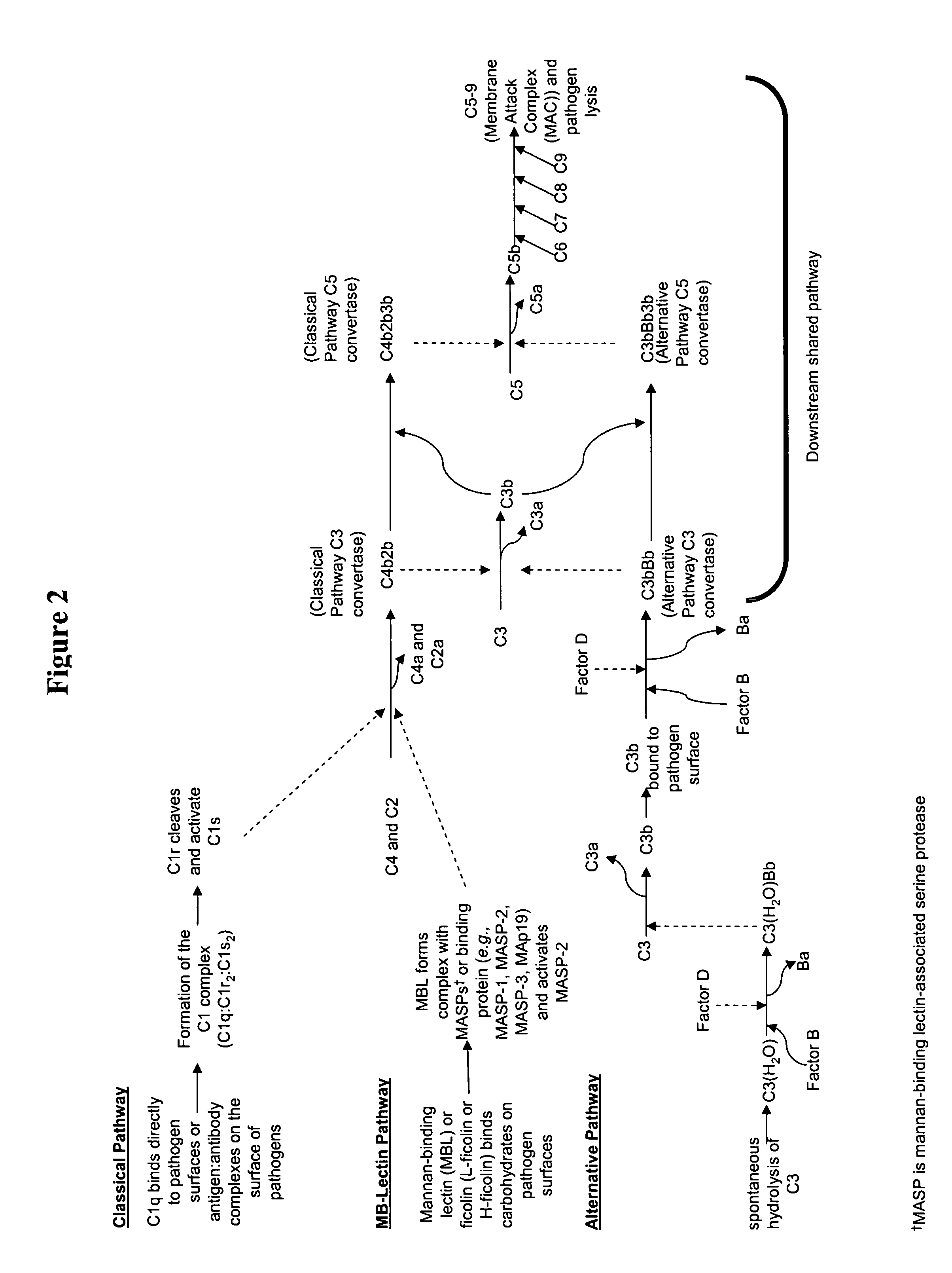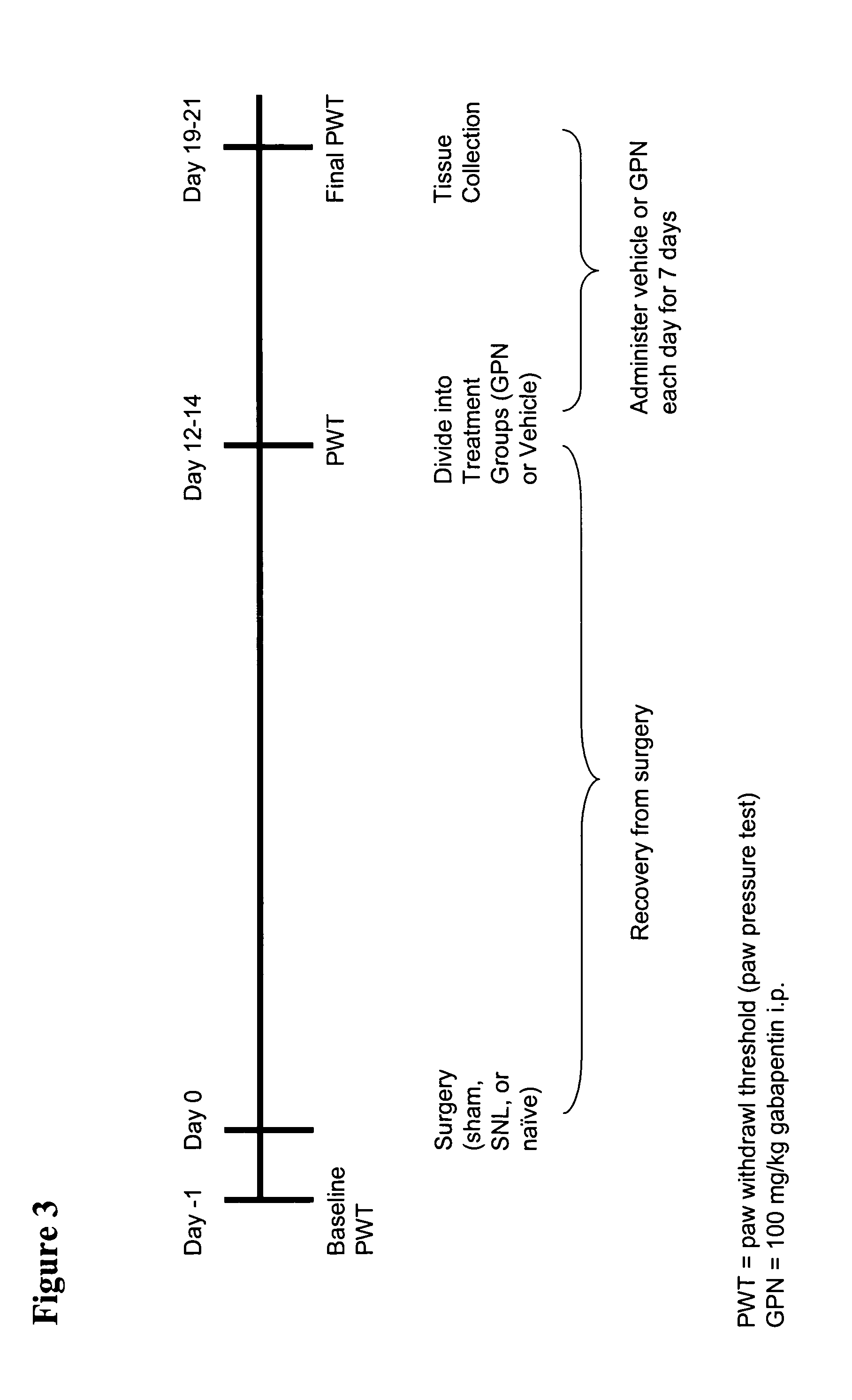Modulation of complement to treat pain
a technology of complement and pain, applied in the field of pain treatment therapy, can solve the problems of debilitating pain, debilitating side effects of analgesics, and often associated with debilitating side effects, and achieve the effects of increasing the biological activity of an endogenous complement inhibitor, and increasing the expression of a nucleic acid molecul
- Summary
- Abstract
- Description
- Claims
- Application Information
AI Technical Summary
Benefits of technology
Problems solved by technology
Method used
Image
Examples
example 1
6.1. Example 1
GeneChip, Taqman, and in situ Analysis of Complement Effectors and Inhibitors in a Neuropathic Pain Model
[0377] The present example provides GeneChip® (Affymetrix, Santa Clara, Calif.), Taqman® (Applied Biosystems, Foster City, Calif.), in situ analysis, and immunohistochemistry data indicating that the expression of many complement effectors increase and the expression of one specific endogenous complement inhibitor decreases in an animal experiencing pain.
6.1.1. GeneChip® Analysis
6.1.1.1. Methods: Preparation of Neuropathic Pain Model
[0378] Rats having the L5-L6 spinal nerves ligated (SNL) according to the method of Kim and Chung, Pain 1992; 50:355-63 were used in this experiment. Briefly, nerve injury was induced by tight ligation of the left L5 and L6 spinal nerves, producing symptoms of neuropathic pain as described below. The advantage of this model is that it allows the investigation of dorsal root ganglia that are injured (L5 and L6) versus dorsal root gang...
example 2
6.2. Example 2
Treating Pain by Inhibition of Complement Using Cobra Venom Factor (CVF)
[0427] The present example demonstrates that rats subjected to the SNL model develop chronic neuropathic pain. When treated with CVF to inhibit complement, the chronic pain is alleviated as exhibited by reduced allodynia in treated rats compared to control rats subjected to SNL without subsequent CVF treatment.
6.2.1. General Methods: CVF Dosing Experiment
[0428] To determine the effect of CVF on complement C3 activity, naïve animals were injected with CVF on days 0, 3, and 6. C3 activity was measured using the hemolysis assay before and after CVF injections as described below.
6.2.2. General Methods: Surgery and CVF Injection Experiment
[0429] The timeline for the general method of surgery followed by CVF injection is outlined in FIG. 8. Spinal nerve ligation (SNL) was performed on Sprague-Dawley rats as described above in Example 1. On day 0, SNL surgery was performed on 20 rats and sham surgery...
example 3
6.3. Example 3
Testing Pain in Animal Model Lacking Complement
[0440] The present prophetic example exemplifies a method for comparing the pain thresholds of C3 knockout mice that undergo spinal nerve ligation surgery with the pain thresholds of naïve mice that undergo spinal nerve ligation surgery. This experiment can be used to determine if elimination of C3 affects the pain state of an animal.
6.3.1. Experimental Overview for C3 Knockout Mouse: SNL Surgery and Behavioral Testing
[0441] C3 Knockout mice from Jackson Laboratory (JAX Research Services, Bar Harbor, Me., Stock Number:003641, Strain Name:B6.129S4-C3tm1Crr / J) can be used to test the effect of complement protein C3 on pain. Spinal Nerve Ligation (SNL) as described below is performed on 10 homozygote C3tm1Crr / J mice and 10 wildtype littermates which are expanded from an earlier cross of heterozygote C3tm1Crr / J mice. Sham surgery is performed on 10 homozygotes C3tm1Crr / J mice and 10 wildtype littermates. Mice are tested for...
PUM
| Property | Measurement | Unit |
|---|---|---|
| Tm | aaaaa | aaaaa |
| Tm | aaaaa | aaaaa |
| Tm | aaaaa | aaaaa |
Abstract
Description
Claims
Application Information
 Login to View More
Login to View More - R&D
- Intellectual Property
- Life Sciences
- Materials
- Tech Scout
- Unparalleled Data Quality
- Higher Quality Content
- 60% Fewer Hallucinations
Browse by: Latest US Patents, China's latest patents, Technical Efficacy Thesaurus, Application Domain, Technology Topic, Popular Technical Reports.
© 2025 PatSnap. All rights reserved.Legal|Privacy policy|Modern Slavery Act Transparency Statement|Sitemap|About US| Contact US: help@patsnap.com



